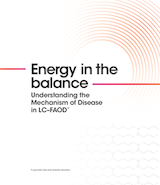Long-chain fatty acid oxidation disorders (LC-FAOD) are a group of rare, life-threatening autosomal recessive disorders1-4
INTRODUCTION TO LC-FAOD PATHOPHYSIOLOGY
The pathophysiology of LC-FAOD is driven by defects in enzymes involved in the carnitine shuttle and long-chain β-oxidation spiral, which are necessary for proper transport and metabolism of long-chain fatty acids (LCFAs).1,4 This results in energy depletion as well as a depletion of intermediate pools of the tricarboxylic acid (TCA) cycle, also known as the Krebs cycle.1,2
HEALTHY FATTY ACID OXIDATION
Fatty acids are a major energy source for the heart, skeletal muscle, and liver. This energy is vital during periods of fasting, when glucose is unavailable, and during times of physiological stress.1,4-8
The metabolism of LCFAs to support energy production centers around oxidation of acetyl-CoA to CO2 in the mitochondrial TCA cycle.1,9,10
Step One
LCFAs enter the mitochondria via the carnitine shuttle system.4,8,13,14
Step Two
LCFAs are metabolized by long-chain–specific enzymes in the long-chain β-oxidation spiral.4,7
Step Three
Acetyl-CoA is produced and then can either1,4:
- Divert to the liver for ketogenesis or
- Enter the TCA cycle to generate ATP through oxidative phosphorylation
ENERGY HOMEOSTASIS RELIES ON THE BALANCE OF ANAPLEROSIS AND CATAPLEROSIS
In proper TCA cycle function, inflow (anaplerosis) is balanced by outflow (cataplerosis).9
In anaplerosis, intermediates are constantly replenished to maintain TCA cycle function and drive ATP production. With cataplerosis, other intermediates are removed to drive gluconeogenesis (production of glucose) and lipogenesis (production of fatty acids). This balance is critical to maintaining energy homeostasis.1,9,10
UNBALANCED METABOLISM IMPAIRS ENERGY PRODUCTION IN LC-FAOD
Enzyme deficiencies in LC-FAOD result in an imbalance between anaplerosis and cataplerosis and can lead to the accumulation of toxic metabolites. This disrupts downstream processes such as gluconeogenesis, ketogenesis (production of ketone bodies), and lipogenesis, compromising energy homeostasis.1,2,9
Enzyme
deficiencies
LC-FAOD is caused by specific enzyme deficiencies in the carnitine shuttle system or the β-oxidation spiral4,12
- CPT I
- CACT
- CPT II
- VLCAD
- TFP
- LCHAD
Compromised
LCFA metabolism
Dysfunctional conversion of LCFAs into acetyl-CoAs results in1,2,7,14
- Lower ATP production
- Impaired ketogenesis
TCA cycle
imbalance
Enzyme deficiencies can disrupt the anaplerosis-cataplerosis balance, leading to1,10,15:
- Accumulation of toxic metabolites
- Lack of replenishing substrates in the TCA intermediate pools
Impaired energy
production
Incomplete TCA cycle processing may impair1,2,7,9,16:
- ATP production
- Gluconeogenesis
References
1. Knottnerus SJG, Bleeker JC, Wüst RCI, et al. Rev Endocr Metab Disord. 2018;19(1):93-106. 2. Wajner M, Amaral AU. Biosci Rep. 2015;36(1):e00281. 3. Lindner M, Hoffmann GF, Matern D. J Inherit Metab Dis. 2010;33(5):521-526. 4. Wanders RJ, Ruiter JP, IJLst L, Waterham HR, Houten SM. J Inherit Metab Dis. 2010;33(5):479-494. 5. Berg JM, Tymoczko JL, Stryer L. Section 30.2. In: Biochemistry. 5th ed. New York: WH Freeman; 2002. 6. Rinaldo P, Matern D, Bennett MJ. Annu Rev Physiol. 2002;64:477-502. 7. Houten SM, Wanders RJ. J Inherit Metab Dis. 2010;33(5):469-477. 8. Kiens B, Roepstorff C. Acta Physiologica Scand. 2003;178(4):391-396. 9. Owen OE, Kalhan SC, Hanson RW. J Biol Chem. 2002;277(34):30409–30412. 10. Brunengraber H, Roe CR. J Inherit Metab Dis. 2006;29(2-3):327-331. 11. Schönfeld P, Wojtczak L. J Lipid Res. 2016;57(6):943-954. 12. Vockley J, Burton B, Berry GT, et al. Mol Genet Metab. 2017;120(4):370-377. 13. Sharpe AJ, McKenzie M. Cells. 2018;7(6):46. 14. Longo N, di San Filippo CA, Pasquali M. Am J Med Genet C Semin Med Genet. 2006;142C(2):77-85. 15. Janeiro P, Jotta R, Ramos R, et al. Eur J Pediatr. 2019;178(3):387-394. 16. Roe C, Brunengraber, H. Mol Genet Metab. 2015;116(4):260-268. 17. Saudubray JM, Martin D, de Lonlay P, et al. J Inherit Metab Dis. 1999;22(4):488-502. 18. Shekhawat PS, Matern D, Strauss AW. Pediatr Res. 2005;57(5 Pt 2):78R-86R. 19. Siddiq S, Wilson BJ, Graham ID, et al. Orphanet J Rare Dis. 2016;11(1):168.
Stay Informed
Sign up to receive the current disease education information in your inbox.
